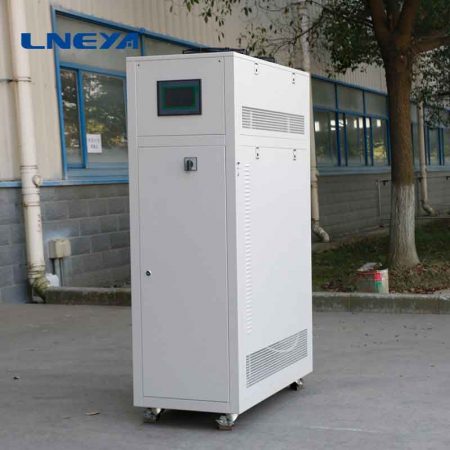A temperature control circulator is a common experimental device used to control the cyclic heating or cooling of substances at different temperatures. The equipment usually consists of a heat source, a cold source, a circulation pump, and a temperature sensor.
Features of temperature control circulator:
1. The magnetically coupled high-temperature circulating pump is used to eliminate the risk of system leakage, with good sealing and high flow rate, ensuring that the equipment can exchange heat for the external system faster
2. Only the medium in the pipeline participates in the circulating temperature control, which reduces the participation of the heat transfer medium and improves the response speed of the system’s high and low temperature control.
3. Equipped with a button LCD screen to display important temperature parameters, which is concise and clear at a glance.
4. Design multiple sets of communication data interfaces, which can be easily connected to various communication networks.
5. Reasonable layout: Frequent operations are all in front of the equipment, pipeline connections are all behind the equipment, and data interfaces are set on the side of the equipment.
6. The standard configuration is the air-cooled type, which does not need an external water source, and is easy to install and operate; the water-cooled type has stable heat dissipation efficiency and is not affected by the ambient temperature.
7. Considering the needs of chemical customers, isolated explosion-proof and positive pressure explosion-proof models can be customized according to the customer’s equipment placement area.
8. A single device can output multiple channels, with multiple reactors and reactor loads, and each channel can achieve independent temperature control. save space.

When using the temperature control circulator, it is first necessary to place the material to be treated in the circulation tank and connect it to the circulation pump through a pipeline. Then, start the circulation pump, so that the material to be treated is pumped into the system and begins to circulate heating or cooling. At this time, by controlling the temperature of the heat source and the cold source, precise control of the substance can be achieved.
The temperature control circulator has a variety of experimental applications, such as chemical reactions, material processing, biological experiments, etc. Among them, one of the most common applications is chemical reactions. In chemical reactions, it is often necessary to control the temperature of the reaction system to control the reaction rate, product selectivity and other factors. The temperature control circulator can effectively improve the reaction efficiency and product purity while reducing the occurrence of side reactions by controlling the reaction system at a constant temperature or periodically controlling the temperature during the reaction.
In addition to chemical reactions, the temperature control circulator can also be used in the field of material processing. For example, when preparing polymer materials, it is necessary to control the temperature of the reaction system to control the molecular polymerization rate and product structure. By using a temperature control circulator for constant temperature or periodic temperature control, efficient and precise polymer material preparation can be achieved.
In terms of biological experiments, temperature control circulators are also widely used. For example, in cell culture experiments, the medium needs to be kept at a constant temperature to promote cell growth. The temperature control circulator can improve the efficiency and quality of cell growth through constant temperature or periodic temperature control. In addition, in protein crystallization experiments, constant temperature or periodic temperature control of the reaction system is also required to promote the formation of protein crystals.
 ЛНЕЙЯ
ЛНЕЙЯ
 简体中文
简体中文

















































































